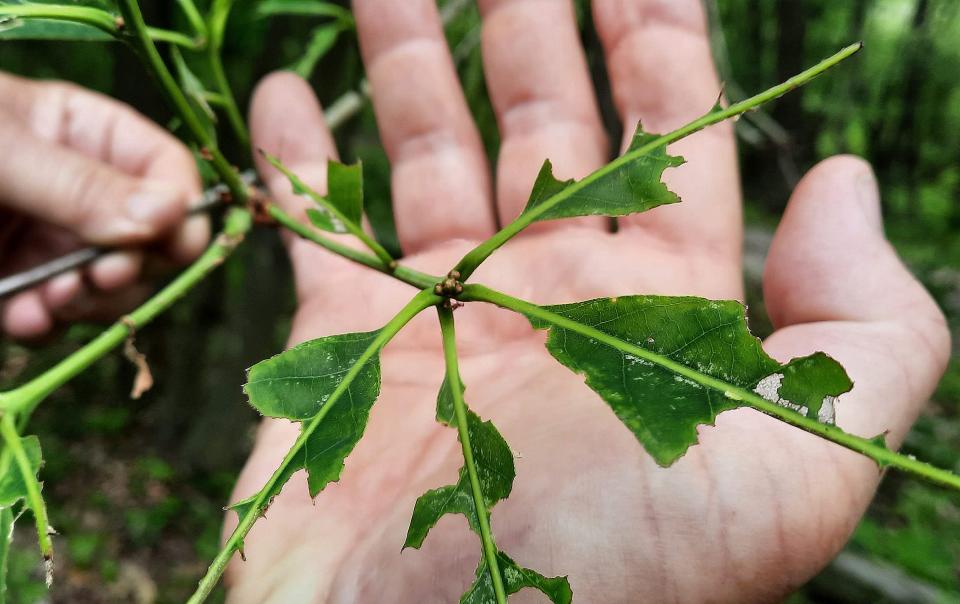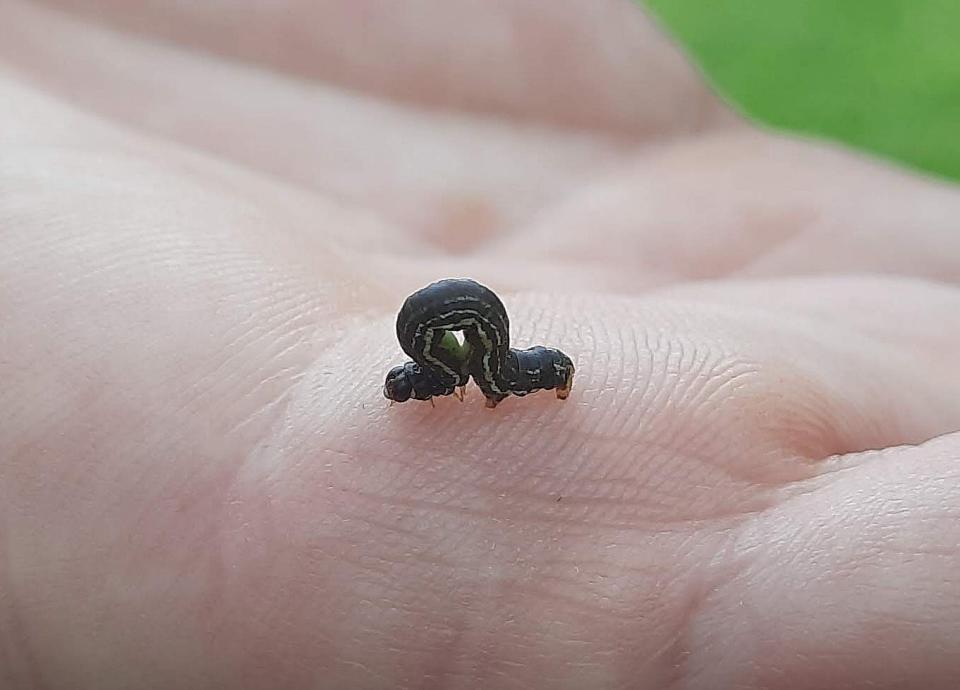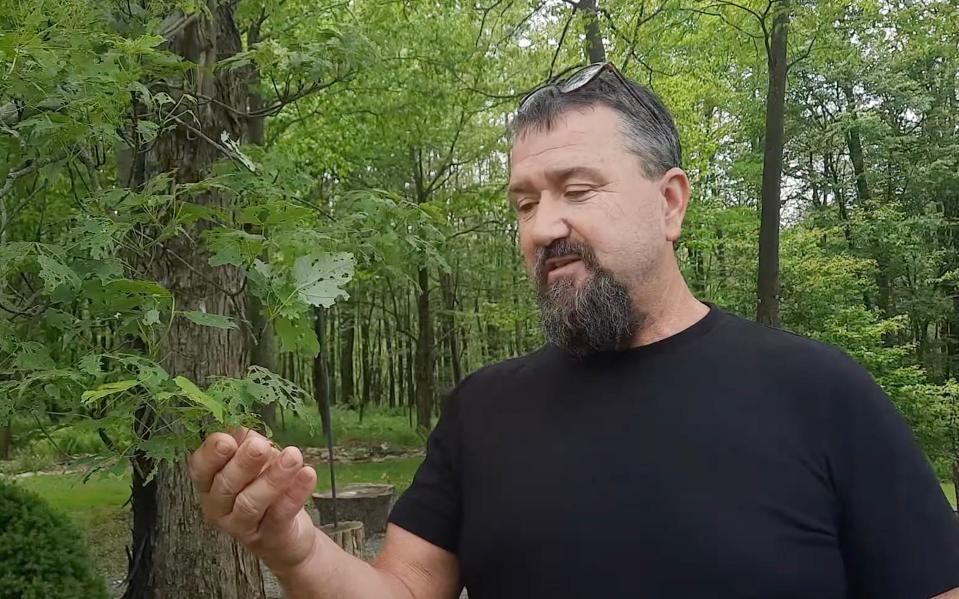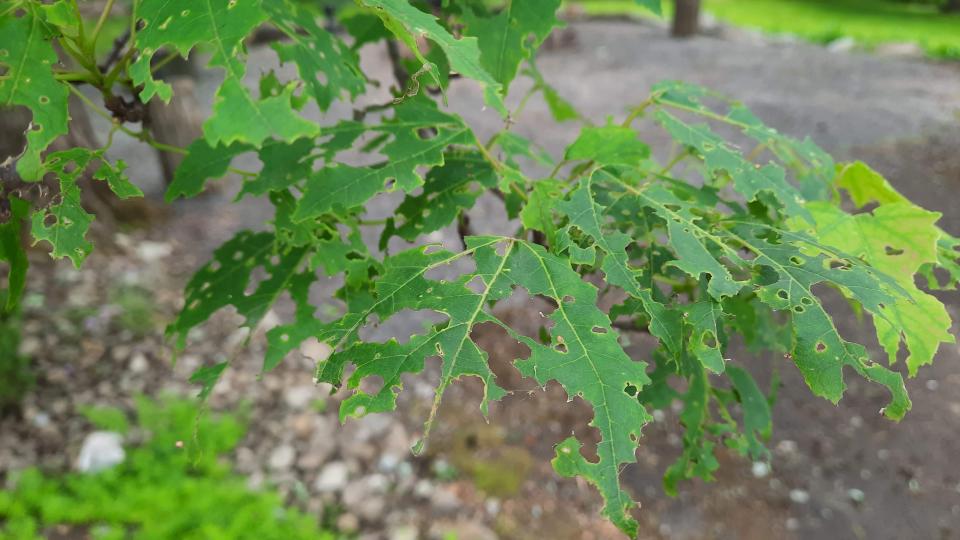Cankerworms defoliated trees in southwestern Pennsylvania. Here's what you need to know
You may be familiar with spongy moths, formerly known as gypsy moths, destroying foliage across Pennsylvania. But there is a native worm that can also cause significant damage in certain parts of the state.

Fall cankerworms are smaller than spongy moth caterpillars but have been known to defoliate a variety of trees. This spring, the little worms have been eating leaves on trees in southwestern Pennsylvania.
Tod Nichols of the Berlin area has lost many leaves on his Somerset County property.
The wooded area near the Garrett Shortcut usually has a canopy of foliage, but not this year.
“It’s become pretty barren with the leaves that we lost,” he said. Walking in the wooded area he is seeing branches and limbs on trees that are usually covered with leaves this time of year. “It’s like it’s early spring.”
In late May, he noticed small holes developing in his leaves.
"Over the weeks after that, they just destroyed more and more each day,” he said.

“They got so bad to a point, where when you walked in the woods, the droppings and such like that you could hear them falling to the ground and they would get on your body and in your hair," he said.
It was similar to the sound of light rain.
Now, in mid-June, the damage appears to have stopped as he’s seeing fewer worms and droppings.
“I think the worst is over,” Nichols said.
The 51-year-old has lived in Somerset County all of his life and was surprised when a forester from the Pennsylvania Department of Conservation and Natural Resources (DCNR) told him what was eating his leaves. Nichols initially thought it was spongy (gypsy) moths that have been in the state for decades. Now that he knows what it is, he said he’s been spotting other places that have similar damage.
“It’s very sporadic, and this seems like a real hot spot for them,” Nichols said.

Dr. Houping Liu, forest entomologist with the DCNR’s Bureau of Forestry, Division of Forest Health, said they have documented several outbreaks of cankerworms in different parts of the state over the years. But so far this year, it’s been mostly southwestern Pennsylvania.
The cankerworms like the leaves on trees like oaks, maples, cherries, ash, beech, apples, dogwood and some types of trees that are used for landscaping, he said.
Major outbreaks happen every 10 to 12 years, he said. Last year, they noticed some damage in the southwestern part of the state on the Laurel Ridges. “It’s mostly oaks this time around,” he said.
Among the places reporting outbreaks include the state forest land in Somerset and Westmoreland counties, along Fire Tower Road near Kooser State Park, between Laurel Ridge and Laurel Hill state parks, and Tunnel Road between Jones Mills and Bakersville along Route 31. He believes southwestern Pennsylvania is more prone to them because of the higher elevation. Somerset County has the highest elevation in the state with Mount Davis being the highest point at 3,213 feet above sea level.
The cankerworms eat leaves for several weeks then drop to the ground where they remain in the soil. In October they will come out again.
“They move around,” he said.
According to Penn State Extension, there have been four major outbreaks of this pest since 1932 in Pennsylvania. The first was in 1953 in the southeastern part of the state. There was a statewide outbreak in 1959. An outbreak occurred from 1964 to 1967 in the northcentral part of the state and again from 1975 to 1977 in the same area.
The good news is that the trees normally survive the infestation from cankerworms.
“Normally with native species they don’t cause huge devastating damage,” Liu said.
Formerly known as gypsy moths: Efforts underway to save oak trees from spongy moths across Pennsylvania
More: High energy prices create windfall for Pennsylvania Game Commission's projects
Summer wildlife: If you find young wild animals, here's what you need to know to keep them and you safe

“Most of the cases, 99%, you don’t have to treat them. They will go away,” he said.
The DCNR encourages people to report sightings of defoliation as the agency monitors what’s happening across the sate.
“For homeowners, we like to hear from you,” Liu said. The general phone number for DCNR is 717-787-2869.
Brian Whipkey is the outdoors columnist for USA TODAY Network sites in Pennsylvania. Contact him at bwhipkey@gannett.com and sign up for our weekly Go Outdoors PA newsletter email on this website's homepage under your login name. Follow him on Facebook @whipkeyoutdoors,Twitter @whipkeyoutdoors and Instagram at whipkeyoutdoors.
This article originally appeared on Erie Times-News: Fall cankerworms eating leaves on trees, what can be done

